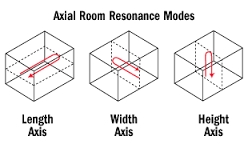Ed's
AV Handbook
Batting practice for the AV Professional
and primer for the novice
Chapter 7 Page 1
An Acoustical Strategy
for the small room

Mr. Hardesty Lightened the Load
The late Richard Hardesty was a respected
audio engineer, consultant, writer, audio reviewer, and I read
he was a respectable pianist. He was also a pioneer of
high-end audiophile retailing in Southern California.
Mr. Hardesty acknowledged that in his early retail days, he drove to his customers' homes with a heavy load of audio test gear to deal with room acoustics.
As time passed, the amount of heavy gear decreased as succeeding visits became a near acoustical replay of the previous visits. Although test gear must have certainly looked cool in the customer's eyes, much of it became unnecessary. It had become apparent that many of their rooms were just another enclosed box with predictable issues and routine acoustical solutions.
The goal of this chapter is to skip the heavy-gear phase. And solve acoustical issues with a practical mix of advice from Mr. Hardesty, the Master Handbook of Acoustics, Auralex Acoustics, long-forgotten sources, plus many of my colleagues.
Mr. Hardesty acknowledged that in his early retail days, he drove to his customers' homes with a heavy load of audio test gear to deal with room acoustics.
As time passed, the amount of heavy gear decreased as succeeding visits became a near acoustical replay of the previous visits. Although test gear must have certainly looked cool in the customer's eyes, much of it became unnecessary. It had become apparent that many of their rooms were just another enclosed box with predictable issues and routine acoustical solutions.
The goal of this chapter is to skip the heavy-gear phase. And solve acoustical issues with a practical mix of advice from Mr. Hardesty, the Master Handbook of Acoustics, Auralex Acoustics, long-forgotten sources, plus many of my colleagues.
The Acoustical Small Room ..... it's your room.
As outlined in Handbook Chapter 2,
wavelength, amplitude, and frequency are used to describe
sound waves. Sound wavelengths range from 56.5 feet to
about 3/4 of an inch. Any room with dimensions
comparable to acoustical wavelengths is acoustically a small
room. Therefore, rooms with a dimension of 56.5 feet, or
less, is an acoustically small room.
Small Rooms Distort
Acoustical small rooms can erupt into
resonating cavities of agitated-low-frequency energy.
The small-room is also an acoustic reflecting mirror of
high-frequency sound that competes with the direct sound from
the speaker system. It may even have a noisy neighbor.
The acoustical-small room is your room with a predisposition
to generate acoustical distortion.
Acoustical Distortion
Audio distortion is the corruption of
reproduced sound. Acoustical-distortion is an audio
distortion created by the room. Three types of sound
perception are affected by acoustical-distortion: timber,
imaging, and spatial impression. Each influenced by the
acoustical-elements of room modes, specular reflections, comb
filtering, absorption, diffusion, and noise. However,
the management of room modes, specular reflections, and noise
is the principle-concern in the acoustical-small room.
Room Modes
Each boundary of the acoustical-small room
causes low-frequency sound waves to resonate, much as waves in
the ocean. They are acoustical-described as standing waves or
room modes. The primary axial room modes of opposite
boundaries (length, width, height) are the most
significant. The wavelengths of the three primary
axial-modes are equal to dividing half the speed of sound by
its room dimension -- length, width, height.
Handbook Note: Speed of sound = 1130 ft /second
Their resonating energy can produce an uneven distribution of low-frequency sound that causes deviations from flat frequency response. That is a principle definition of distortion.
Handbook Note: Speed of sound = 1130 ft /second
Their resonating energy can produce an uneven distribution of low-frequency sound that causes deviations from flat frequency response. That is a principle definition of distortion.

Specular Reflections
Specular reflections are room boundary
reflections of a short-acoustical wavelength that compete with
the direct sound from a speaker. Their physics is
identical to a ray of light reflecting off a mirror.
Formally defined as the angle of incidence equals the angle of
reflection, specular reflections distort imaging, and spatial
impression.

Noise
Noise is a random unwanted competing
sound. Noise generated within a room or adjoining areas
distorts imaging, timber, spatial impression, and compresses
the dynamic range of sound. Noise is the most corruptive
acoustical distortion.
Ed's AV Handbook
Copyright 2007 Txu1-598-288 Revised 2024
Sponsored By

Architectural Speaker Tuning System
for
in-wall/ceiling custom installed speakers.
Reclaim
The Performance You Paid For
Site Menu
Home
Table of
Contents
AV News & Blog
Handbook Chapters
1 AV
Terms
2 AV Physics
3 Sound Reproduction
4 Video Reproduction
5 The AV System Sequence
6 The Room, Speaker, & TV
7 Acoustical Strategy - Small Room
8 Home Theater by Design
9 AV Sales Training
10 AV Business & Marketing
Contact
About